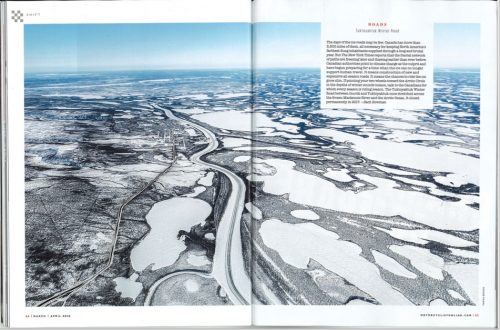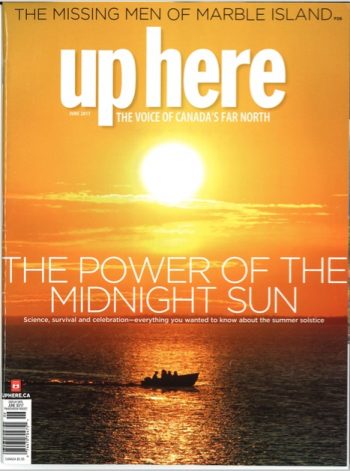
Selling photos this way (also called direct licensing) essentially lets me be my own stock agency.
I have much more control over my fees and how my photos are used. And I don’t have to query editors, or sit around and wait for people to buy my stock photos.
Yes, I DO have to go out and find my own clients and find ways of keeping them—but it’s well worth it.
For example, in my very first direct licensing contract, 19 images were licensed for a 3-year term for $5,700!
How did I find this client? It was serendipitous. I came from a casual chat with a Federal government worker who mentioned they have a budget for images. I said I’m a photographer. She asked me to send a link to my work.
Some of the photos this client chose from my collection surprised me. One was a simple gravel highway with wildflowers on the side.
It’s exactly as Great Escape says in all their courses – that most of the time it’s not the prettiest pictures that sell best.
My website, with images keyworded on each page, has been my greatest sales tool. That, and always telling people I’m a photographer.
Publications or companies often contact me directly through my site with their requests, which requires little to no effort on my part. Fortunately, this makes up the bulk of my licensing contracts.
Over the past few months, I’ve sold multiple photos to various clients, and all but one were unsolicited. These clients included Canadian Geographic, a government department, a local tourism agency, and an educational company.
All told, they’ve agreed to buy $3,750 worth of images with other potential contracts pending. And again, they found me. I didn’t go our searching for them.
Here are some tips if you’re interested in direct licensing your photos:
Be discoverable: Your website and social media
It’s important to have an online presence, through social media platforms (Instagram, Facebook, Flickr, YouTube) so potential buyers can find you easily.
You should have a website with quality images that are properly keyworded, and supplemented with a blog page where you can feature quality content.
I know properly and thoroughly keywording images on my website has played a large part in clients finding me directly.
Motorcyclist Magazine contacted me directly, and paid $400 for a double page single use of this image.
Tracks and Treads Magazine (industry) contacted me directly to license images to go along with an existing story authored by someone else; seven of my images were used, which included the cover! I was paid $1,300.
How to get licensing contracts
Licensing contracts generally result from two different avenues: having clients find you via your online presence, or by you going out to find your own potential clients.
Here’s an example of one client that I found.
Local regional magazine UpHere put a call out to photographers for midnight sun images (I was already on their email list of local professional photographers). Mine was selected for the cover page, along with a second smaller image used in the article. I was paid $260.
Know what to charge
Over the years, I’ve set my fee schedule to be in line with other established photographers—both locally and nationally. In Canada, there is an industry standard fee calculator that is very helpful: “Canadian Artists Representation Minimum Copyright and Professional Fees Calculator”. A similar resource for the United States is the American Society of Media Photographers.
My fees are reflective of a number of variables, including client-type (e.g. industry vs. non-profit), type of publication, size and location of distribution, size of image to be used, length of time to be used, exclusivity, cost to produce the image, and whether it will be published in print or digital format, or on the web.
To make it more attractive for clients, consider offering a reduced rate for multiple images that are purchased as a package.
How to get started:
1) Identify and contact potential clients. Start locally. If you have a wide selection of images depicting various aspects of your region, contact your local tourism agency, chamber of commerce, specific departments of different levels of government (state/federal/municipal), community associations, industry associations, etc.
Note: Year-end is a good time to reach out, as many businesses have leftover funds in their budget to spend.
2) Make it easy for clients to review your images. Upload a sample selection relevant to their business to a Dropbox folder or other cloud-based storage (low resolution, around 900 pixels wide, 72 ppi, with faint watermark), and provide the link to the potential client. Let them know you can provide more images if needed. Once you initiate this relationship, there is potential for an ongoing arrangement!
3) Know your worth. Have a pre-determined fee schedule to offer to clients, while remaining open to work within the client’s budget. Before you spend a lot of time working with a potential client, be sure to discuss fees in advance. They don’t need to commit to anything, but it’s helpful to know that you are both in the same ballpark in terms of fees.
4) Don’t say yes to everything. If a company wants to license your images and offers you $25 per image when you would normally charge $100, attempt to close the gap a bit. If that doesn’t work, it’s completely fine to thank the company for their interest and kindly decline the offer – unless it’s worth it for the exposure and prestige of their publication, or the potential for an ongoing relationship.
5) Have a licensing agreement that sets out the terms and conditions that are being agreed to; both you and the client would sign off on the agreement. Sometimes a client may have their own license agreement; in that case, be sure to read it carefully.
Travel Photography Resources
5 Dos and 2 Don’ts for Travel Photography
Take Great Photos And Get Paid More For Your Travel Articles
Turning a Photography Hobby into a Monthly Income
The Pros Of Selling Your Images As Stock Photography
16 Mobile Photography Tips And Tricks Every Photographer Should Know




